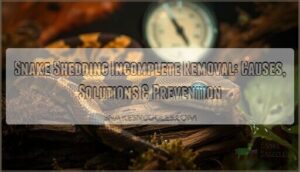This site is supported by our readers. We may earn a commission, at no cost to you, if you purchase through links.

Proper hydration affects everything from successful shedding to kidney function and immune system strength.
Snakes obtain water through drinking, environmental moisture absorption, and prey consumption.
Dehydration symptoms include wrinkled skin, sunken eyes, and retained sheds.
Even mild dehydration can cascade into serious health problems, including organ failure and increased infection susceptibility.
Your snake’s water needs vary by species, size, and environmental conditions, making proper hydration management both an art and a science that requires understanding their unique physiological adaptations.
Table Of Contents
- Key Takeaways
- Snake Hydration Needs
- Hydration Techniques in Snakes
- Effects of Dehydration
- Rehydrating Dehydrated Snakes
- Preventing Snake Dehydration
- Frequently Asked Questions (FAQs)
- What happens if a snake is dehydrated?
- What is the importance of good hydration?
- Why are water snakes important?
- How long can snakes go without drinking water?
- What are the effects of poor hydration in snakes?
- Why is water important for snakes?
- How do snakes hydrate themselves?
- How long does it take to rehydrate a snake?
- Do snakes need different water sources in captivity?
- How often should I change my snakes water?
- Conclusion
Key Takeaways
- You’ll prevent serious health complications by maintaining proper humidity levels (50-70%) and providing fresh water sources, since dehydration affects everything from shedding to organ function
- You can spot dehydration early by checking for sunken eyes, wrinkled skin, and incomplete sheds—these warning signs help you take action before it becomes life-threatening
- Your snake gets water through drinking, environmental moisture absorption, and prey consumption, so you’ll need to support all three methods in captivity
- You’ll see improvement within 24-48 hours when rehydrating a dehydrated snake through proper soaks, increased humidity, and veterinary care for severe cases
Snake Hydration Needs
Understanding your snake’s hydration needs is essential for maintaining their health and preventing serious complications.
Water plays a vital role in their metabolism, digestion, and temperature regulation, while proper humidity levels support healthy shedding and respiratory function.
Water isn’t just refreshing—it’s your snake’s lifeline for every critical body function.
Physiological Requirements
Your snake’s body operates like a finely-tuned machine where water balance drives every essential function.
Understanding these physiological needs helps you provide proper care for ideal health and longevity.
- Water Balance: Maintains cellular function and prevents organ failure
- Thermal Regulation: Enables proper temperature control through blood circulation
- Metabolic Rate: Supports digestion and energy production processes
- Respiratory Function: Keeps airways moist for efficient breathing
- Nutrient Uptake: Facilitates vitamin and mineral absorption throughout the body
Importance of Water Intake
Your snake’s water balance directly impacts its survival and overall health.
Proper hydration methods vary dramatically between species – desert survival specialists like rattlesnakes conserve every drop, while aquatic adaptation allows water snakes to thrive in moisture-rich environments.
Snake behavior changes noticeably when dehydrated, affecting feeding patterns and activity levels, which is crucial for understanding reptile water intake and snake drinking habits to provide ideal care.
These hydration importance factors determine your pet’s long-term wellness and water requirements.
Role of Humidity in Hydration
Humidity control plays a pivotal role in maintaining your snake’s water balance and overall health.
Your snake environment requires specific moisture levels to support proper hydration – atmospheric conditions that are too dry can lead to serious dehydration risks.
When humidity drops below ideal ranges, your pet can’t absorb moisture effectively through its skin, disrupting natural water absorption methods and creating dangerous health complications.
Maintaining proper snake housing humidity is essential for preventing dehydration, and understanding the importance of humidity levels can help you create a healthy environment for your pet, which is crucial for its overall well-being.
Hydration Techniques in Snakes
You’ll discover that snakes employ four primary methods to maintain proper hydration levels in their natural habitats.
These techniques range from direct water consumption to sophisticated moisture absorption systems that help them survive in challenging environments, utilizing complete concepts to ensure their survival.
Drinking From Water Sources
You’ll notice snakes don’t lap water like dogs—they’re nature’s tiny vacuum cleaners! Using specialized jaw muscles, they create suction to draw water through their sponge-like lower jaw structures.
Fresh sources remain essential since most species refuse saline water. Your snake’s drinking behavior involves precise aquatic access timing, with some spending four minutes per session.
These hydration methods showcase remarkable adaptations across species. Snakes require regular access to clean water sources to stay healthy and thrive in their environment with clean water.
Hydration Through Food
Frequently, your snake obtains essential dietary hydration through prey items containing high water content.
Fresh rodents provide approximately 70% moisture, making feeding strategies vital for maintaining proper nutrient balance.
Frozen-thawed prey retains most food moisture, supporting reptile hydration needs effectively, and this natural snake nutrition advice guarantees your pet receives adequate hydration through regular meals, ensuring proper nutrient balance.
Absorbing Moisture From Environment
Many species naturally draw moisture from their surroundings when direct water sources aren’t available.
Environmental humidity plays a vital role in snake hydration through skin absorption and water vapor uptake. Atmospheric moisture helps prevent dehydration, especially for arboreal species that collect raindrops on their scales.
Proper moisture absorption supports healthy skin hydration and reduces reptile hydration needs substantially.
Snakes also rely on prey for hydration for their water intake, which is a crucial aspect of their hydration needs and overall survival, highlighting the importance of environmental humidity and moisture absorption.
Specialized Hydration Techniques
Several remarkable adaptations help snakes maintain hydration beyond conventional drinking methods.
These specialized techniques showcase nature’s ingenuity in solving water challenges.
Advanced Snake Hydration Techniques:
- Electrolyte Solutions – Veterinarians administer balanced fluids to restore mineral levels during severe dehydration episodes
- Subcutaneous Fluids – Injectable hydration delivered under the skin provides rapid rehydration for critically dehydrated snakes
- Nebulization Therapy – Humidified air treatments help respiratory hydration while supporting overall moisture absorption
- Oral Syringing – Careful water administration directly into the mouth assists snakes unable to drink independently
Maintaining proper humidity prevents retained shed issues.
Effects of Dehydration
When you notice your snake showing signs of dehydration, you’re looking at a serious health concern that can quickly escalate from manageable to life-threatening.
Understanding these warning signs and their progressive impacts will help you take swift action to protect your serpent’s health and prevent potentially fatal complications.
Recognizing Dehydration Symptoms
When your snake starts looking like it’s been through a desert marathon, dehydration’s likely knocking at the door.
Sunken eyes and skin wrinkling are classic red flags, while shedding problems create patchy, incomplete molts.
You’ll notice lethargic behavior replacing normal activity, and a dry mouth signals serious hydration issues.
These snake health tips emphasize the importance of hydration for proper snake care.
Consequences of Mild Dehydration
When your snake’s water levels drop even slightly, you’ll notice the first warning signs creeping in.
Reduced Appetite becomes evident as Impaired Digestion affects their feeding response.
Lethargy sets in, making your pet less active than usual, and Shedding Problems emerge as skin loses elasticity, creating incomplete molts.
Organ Stress begins silently affecting internal functions, and these snake health tips emphasize the importance of hydration—proper snake care prevents these early dehydration consequences from escalating into serious health issues, highlighting the need for proper snake care.
Impact of Severe Dehydration
When severe dehydration strikes, you’re looking at a life-threatening emergency that can devastate your snake’s entire system.
Severe dehydration turns your snake’s body into a failing system demanding immediate emergency intervention.
This critical stage threatens multiple organ systems and requires immediate intervention to prevent irreversible damage.
- Organ Failure – Kidneys shut down first, followed by liver dysfunction as physiological functions collapse
- Skin Damage – Severe elasticity loss creates permanent tissue damage and chronic shedding problems
- Respiratory Distress – Thickened blood increases death risk through compromised circulation and breathing difficulties
Increased Risk of Health Issues
Dehydration creates a domino effect of health problems that can seriously harm your snake.
Weakened Immunity makes your pet vulnerable to bacterial infections and scale rot.
Shedding Difficulties become common when skin lacks proper moisture.
Respiratory Issues develop as mucous membranes dry out.
Digestive Complications arise when the gut can’t process food effectively.
Kidney Problems emerge from prolonged water loss, potentially causing permanent damage.
Rehydrating Dehydrated Snakes
When you notice signs of dehydration in your snake, quick action can prevent serious health complications.
You’ll need to assess the severity and choose appropriate rehydration methods, from simple soaks to emergency veterinary care.
Identifying Dehydration Severity
Check skin elasticity by gently pinching your snake’s side—healthy skin snaps back immediately.
Sunken eyes indicate dehydration, while bright eyes suggest proper hydration. Incomplete shedding problems often signal water deficiency.
Monitor urination frequency; less frequent urination suggests dehydration. Watch for behavior changes like lethargy or reduced appetite, which typically accompany dehydration in reptiles.
Dull scales can also indicate reduced skin elasticity, signaling a potential issue with dehydration in your pet snake, which may require checking for proper hydration and addressing water deficiency.
Providing Rehydration Methods
Once you’ve assessed dehydration severity, you’ll need to choose appropriate hydration strategies.
Electrolyte soaks provide immediate relief—place your snake in shallow, lukewarm water with diluted sports drink for 15-60 minutes.
Habitat misting increases environmental humidity, while oral syringing offers controlled fluid delivery for alert snakes.
Bathing techniques and subcutaneous fluids address more serious cases effectively.
Understanding proper snake electrolyte soak methods is essential for effective rehydration, utilizing electrolyte soak techniques to achieve effective rehydration and provide immediate relief.
Veterinary Intervention
When professional help becomes necessary, veterinary care offers specialized snake therapy and medical treatment options.
Experienced reptile veterinarians can administer subcutaneous fluids, provide emergency response protocols, and perform life-saving interventions that home remedies simply can’t match.
- Fluid therapy – Vets inject saline solutions directly under the skin for rapid rehydration
- Diagnostic testing – Blood work reveals electrolyte imbalances and organ function status
- Advanced monitoring – Professional equipment tracks essential signs during recovery procedures
- Emergency protocols – Critical cases may require intensive care or specialized reptile surgery
Preventative Measures
Beyond creating a perfect habitat, you’ll want to establish routines that keep your snake’s hydration on track.
Regular Health Checks help spot early warning signs, while consistent Environmental Monitoring guarantees Humidity Control stays within species-specific ranges.
Quality Water Quality matters—change bowls weekly and position them strategically for easy access.
Think of Snake Nutrition as hydration support too, since prey items contribute moisture.
These snake hydration tips become second nature with practice, making dehydration prevention effortless.
Preventing Snake Dehydration
You’ll want to establish proper hydration protocols before dehydration becomes a problem in your snake’s enclosure.
Prevention requires consistent monitoring of humidity levels, water availability, and environmental conditions that support your snake’s natural hydration needs.
Proper Enclosure Management
Your snake’s home is their lifeline – get the foundation right, and you’ll prevent most dehydration problems before they start.
Smart Enclosure Design with proper substrate selection and ventilation management creates the perfect environment for reptile hydration systems to work effectively.
- Choose water-retaining substrates like cypress mulch for desert snake care
- Install reliable temperature control systems to prevent moisture loss
- Design proper ventilation that maintains airflow without creating drafts
- Position snake water sources strategically throughout the habitat
Proper snake care involves understanding rehydration methods to keep your pet healthy.
Maintaining Optimal Humidity
Digital hygrometers help you track humidity levels between 50-70% for most species.
Misting systems and moisture-retaining substrates like sphagnum moss create stable Environmental Factors.
Humid hides let your snake self-regulate Hydration Levels when needed.
Poor Humidity Control affects Snake Behavior and shedding cycles.
Monitor daily fluctuations to prevent dehydration while avoiding excessive moisture that encourages bacterial growth.
Accurate humidity readings rely on using a digital hygrometer device to maintain the best conditions.
Providing Adequate Water
Water bowl placement sets the foundation for proper snake hydration.
Position shallow, heavy bowls that won’t tip over in cooler areas of the enclosure.
Change water every few days to maintain water quality and prevent bacterial growth.
Some species benefit from occasional snake baths using lukewarm water.
Clean freshwater sources support natural hydration methods while complementing your humidity control system.
This approach ensures proper snake hydration and maintains a healthy environment.
Monitoring Health and Warning Signs
Regular health checks reveal dehydration warning signs before they become serious medical alerts.
Watch for sunken eyes, wrinkled skin, and incomplete sheds—these snake behavior changes signal your pet’s water needs aren’t met.
Weekly dehydration tests help catch problems early, and checking skin elasticity is crucial for proper reptile care.
Monitoring eating patterns is also essential, as recognizing these essential animal health indicators is vital for ideal snake hydration.
Frequently Asked Questions (FAQs)
What happens if a snake is dehydrated?
Like ancient desert nomads treasuring precious water, you’ll notice your snake showing sunken eyes, wrinkled skin, and incomplete sheds when dehydrated.
They’ll become lethargic, refuse food, and struggle with thermoregulation, potentially leading to serious health complications, including issues with thermoregulation.
What is the importance of good hydration?
Proper hydration keeps your snake’s organs functioning smoothly, supports healthy shedding cycles, and prevents dehydration-related illnesses.
You’ll notice better appetite, activity levels, and overall wellness when water needs are met consistently, which is crucial for maintaining healthy shedding cycles.
Why are water snakes important?
Think of wetland ecosystems as nature’s filtration systems—water snakes act as their quality control inspectors.
You’ll find these serpents controlling fish populations, reducing disease spread, and maintaining aquatic balance that keeps freshwater habitats healthy for countless species, which is crucial for ecosystems.
How long can snakes go without drinking water?
Most snakes can survive 10-14 days without drinking water, though desert species like rattlesnakes handle longer periods.
You’ll notice dehydration signs—wrinkled skin, sunken eyes—well before it’s dangerous for your pet.
What are the effects of poor hydration in snakes?
Poor hydration devastates your snake’s health.
You’ll notice sunken eyes, wrinkled skin, incomplete sheds, and respiratory problems.
Dehydration affects feeding behavior, thermoregulation, and activity levels, ultimately compromising survival and reproductive fitness in wild populations, leading to severe consequences such as respiratory problems.
Why is water important for snakes?
Like a lifeline in the desert, water keeps your snake alive by regulating body temperature, aiding digestion, enabling proper shedding, and maintaining healthy organ function throughout their entire life.
How do snakes hydrate themselves?
You’ll find snakes drinking directly from water sources like streams, puddles, and rain droplets.
They also absorb moisture through their skin, collect dew on specialized scales, and obtain water from their prey’s body fluids during feeding, which can be considered complete concepts of how snakes gather water, including absorbing moisture through their skin.
How long does it take to rehydrate a snake?
Think of a wilted houseplant bouncing back after watering—snake rehydration follows similar principles.
You’ll typically see improvement within 24-48 hours with proper humidity and water access.
Severely dehydrated snakes may need several days to fully recover their normal skin elasticity and activity levels.
Do snakes need different water sources in captivity?
You’ll want to provide both a primary water bowl and occasional soaks for ideal hydration.
Fresh, dechlorinated water in a heavy ceramic bowl works best, while adding humid hides helps maintain proper moisture levels throughout their enclosure, which is crucial for their well-being and involves proper maintenance.
How often should I change my snakes water?
Studies show 70% of captive snakes suffer from water-related health issues when bowls aren’t cleaned regularly.
You should change your snake’s water every 3-5 days, or immediately if it’s soiled with substrate or waste.
Conclusion
Picture your snake gliding gracefully through its enclosure, skin glistening with health—this vision depends entirely on proper hydration management.
The importance of snake hydration extends beyond basic survival, affecting every aspect of your reptile’s wellbeing from cellular function to behavioral patterns.
You’ve learned how dehydration cascades into serious complications, but you also know prevention is straightforward with consistent monitoring and proper husbandry.
By maintaining ideal humidity levels, providing clean water sources, and recognizing early warning signs, you’re ensuring your snake thrives rather than merely survives in captivity, which is the ultimate goal of proper husbandry and consistent monitoring.
- https://www.lllreptile.com/articles/110-water-and-hydration-for-herps
- https://pmc.ncbi.nlm.nih.gov/articles/PMC7938798/
- https://wheremyscalesslither.weebly.com/dehydration.html
- https://journals.biologists.com/jeb/article/226/15/jeb245925/325821/Dehydrated-snakes-reduce-postprandial-thermophily
- https://reptifiles.com/corn-snake-care-guide/sick-corn-snake-diseases-health/dehydration/
















